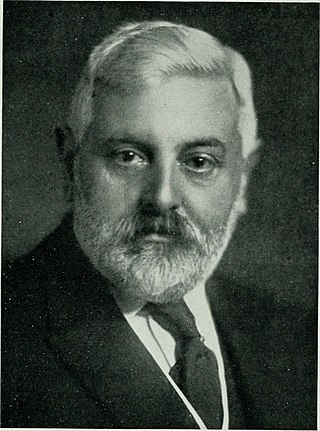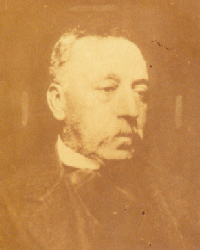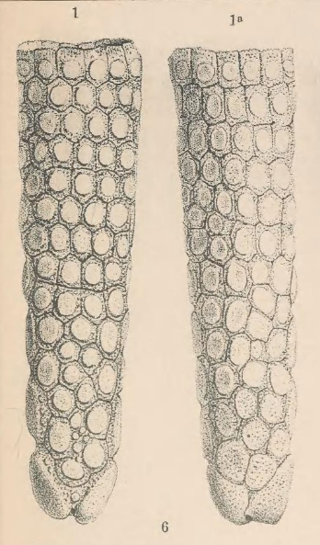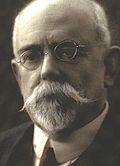
Francisco Pascasio Moreno was a prominent explorer and academic in Argentina, where he is usually referred to as Perito Moreno. Perito Moreno has been credited as one of the most influential figures in the Argentine incorporation of large parts of Patagonia and its subsequent development.

Florentino Ameghino was an Argentine naturalist, paleontologist, anthropologist and zoologist, whose fossil discoveries on the Argentine Pampas, especially on Patagonia, rank with those made in the western United States during the late 19th century. Along with his two brothers – Carlos and Juan – Florentino Ameghino was one of the most important founding figures in South American paleontology.
Palaeospheniscus bergi is a species of the extinct penguin genus Palaeospheniscus. It stood about 60 to 75 centimetres high in life, or somewhat smaller on average than the extant African penguin.

Astrapotheria is an extinct order of South American and Antarctic hoofed mammals that existed from the late Paleocene to the Middle Miocene, 59 to 11.8 million years ago. Astrapotheres were large, rhinoceros-like animals and have been called one of the most bizarre orders of mammals with an enigmatic evolutionary history.

Interatherium is an extinct genus of interatheriid notoungulate from the Early to Middle Miocene (Colhuehuapian-Mayoan). Fossils have been found in the Santa Cruz, Collón Curá and Sarmiento Formations in Argentina.

Patagornis is a genus of extinct flightless predatory birds of the family Phorusrhacidae. Known as "terror birds", these lived in what is now Argentina during the Early and Middle Miocene; the Santa Cruz Formation in Patagonia contains numerous specimens. Patagornis was an agile, medium sized Patagornithine and was likely a pursuit predator.

The Bernardino Rivadavia Natural Sciences Argentine Museum is a public museum located in the Caballito neighborhood of Buenos Aires, Argentina.

The Bernasconi Institute is an architecturally-significant primary school in the Parque Patricios section of Buenos Aires.

Juan Bautista Ambrosetti was an Argentine archaeologist, ethnographer and naturalist who helped pioneer anthropology in his country.

Astrapotheriidae is an extinct family of herbivorous South American land mammals that lived from the Late Eocene to the Middle Miocene 37.71 to 15.98 million years ago. The most derived of the astrapotherians, they were also the largest and most specialized mammals in the Tertiary of South America. There are two sister taxa: Eoastrapostylopidae and Trigonostylopidae.

Carlos Ciriaco Ameghino was an Argentine paleontologist and explorer who accompanied his brother Florentino Ameghino throughout Argentina searching for fossils.
Santiago Roth was a Swiss Argentine paleontologist and academic known for his fossil collections and Patagonian expeditions.

Lomaphorus is a possibly dubious extinct genus of glyptodont that lived during the Pleistocene in eastern Argentina. Although many species have been referred, the genus itself is possibly dubious or synonymous with other glyptodonts like Neoslerocalyptus from the same region.

Astraponotus is an extinct genus of astrapotheriids. It lived during the Middle-Late Eocene and its fossil remains have been found in the Sarmiento Formation of Argentina, South America.

Zulma Nélida Brandoni de Gasparini is an Argentine paleontologist and zoologist. She is known for discovering the fossils of the dinosaur Gasparinisaura, which was named after her.
Dryornis, also called the Argentinian vulture, is an extinct genus of cathartid, known from Argentina. The genus contains two species, D. pampeanus and D. hatcheri.
Polymorphis is an extinct genus of litopterns belonging to the family Macraucheniidae. It lived during the Middle Eocene of Argentina.

Prozaedyus is an extinct genus of chlamyphorid armadillo that lived during the Middle Oligocene and Middle Miocene in what is now South America.
Plohophorus is an extinct genus of glyptodont. it lived from the Late Miocene to the Late Pliocene, and its fossilized remains were discovered in South America.

Peltephilidae is a family of South American cingulates (armadillos) that lived for over 40 million years, but peaked in diversity towards the end of the Oligocene and beginning of the Miocene in what is now Argentina. They were exclusive to South America due to its geographic isolation at the time, one of many of the continent's strange endemic families. Peltephilids are one of the earliest known cingulates, diverging from the rest of Cingulata in the Early Eocene.


























